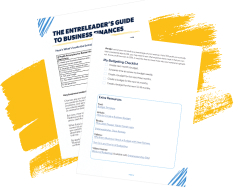How to Create a Basic Business Budget Step by Step
8 Min Read | Oct 31, 2025

Key Takeaways
- Write down your revenue streams. List every way your business makes money—no numbers yet, just sources.
- Write down the cost of goods sold. If you sell products, note what they cost you.
- List your expense categories. Track all business expenses, big and small, so money doesn’t slip through the cracks. Common categories are payroll, rent, utilities, insurance, supplies and equipment, marketing, technology, and training or coaching for your team.
- Plug in your own numbers and calculate your expected profit (or loss). Subtract expenses and costs from revenue to see where you stand.
- Work toward a 12-to-18-month business budget. Start with one month, then keep going for better long-term planning.
You’d never intentionally set your business up to fail. But if you don’t know your numbers or how to create a business budget, that’s exactly what you’re doing. Money problems and bad accounting are two reasons why many small businesses don’t make it past their first five years.1
We get it. Talking about budgets can feel overwhelming. It’s way more fun to dream up new ideas and get stuff done than it is to dig in to financials. But steady, sustainable growth depends on knowing exactly what’s coming in and going out of your business.
Not a numbers person? That’s okay. Follow the simple steps below to learn how to create a business budget and manage your finances with confidence. And when you’re ready, download the EntreLeader’s Guide to Business Finances with a free, easy-to-use business budget template to help you start strong.
But before we get to that, let’s unpack what a budget is and why you need one.
Don't Let Your Numbers Intimidate You
With the EntreLeader’s Guide to Business Finances, you can grow your profits without debt—even if numbers aren’t your thing. Plus, get a free business budget template as part of the guide!
What Is a Budget?
A business budget is a plan for how you’ll use the money your business generates every month, quarter and year. It’s like looking through a windshield to see the expenses, revenue and profit coming down the road.
Your business budgeting process helps you decide what to do with profit, when and where to cut spending and grow revenue, and how to invest for growth when the time comes.
Leadership expert John Maxwell puts it this way: “A budget is telling your money where to go instead of wondering where it went.”
But here’s what a business budget is not: a profit and loss (P&L) report you read at the end of the month. Your P&L is like a rearview mirror—it lets you look backward at what’s already happened. Your P&L and budget are meant to work together so you can spot problems early, forecast wisely, set educated goals, and stay on track to reach them.
Why Do I Need Business Budgeting?
Business budgeting should be your very first accounting task because your business won’t survive without it.
Sound dramatic? Check this out: Between 1994 to 2021, 67.9% survived at least two years. But fewer than half survived past five years.2 The biggest reasons? Cash-flow problems, poor pricing and cost control, and lack of a business strategy.
As a business owner, one of the worst feelings in the world is wondering if you’ll be able to make payroll and keep your doors open. A business budget helps you avoid money mistakes, stay in control, and find real financial peace.
It will also help you:
- Maximize the money you have
- Manage your cash flow with confidence
- Spend less than your business earns
- Stay on top of taxes and bills
- Track whether you’re hitting your numbers
Your Road Map to Grow Your Business
Dave Ramsey’s new book Build a Business You Love is now available for purchase! This book will walk you through the same proven system Dave Ramsey used to build Ramsey Solutions from a card table in his living room to a $300 million company.
1. Write down your revenue streams.
Your revenue is the money you earn in exchange for your products or services. Start your small- business budget by identifying every way your business makes money. This gives you a full picture of what’s fueling your cash flow before you ever plug in numbers.
Look at last month’s P&L—or even just your business checking account—to jog your memory. Write down every stream of income: product sales, service fees, subscriptions, consulting work or project-based revenue.
For example, if you own an HVAC company, your list might include:
- Maintenance service calls
- Repair services and sales
- New unit installation
- Insulation or ductwork upgrades
- Air quality testing
Pro tip: Don’t skip small or seasonal sources of income. They may not drive your business, but tracking them helps you forecast more accurately.
2. Write down the cost of goods sold (COGS).
If your business sells physical products—or delivers a service that requires materials—this step is key.
Your COGS includes any direct costs needed to create or deliver your product or service. Think of it this way: If you had to produce one more sale tomorrow, what costs would you immediately incur? That’s your COGS.
Here are some examples for different industries:
- HVAC company: units, thermostats, ductwork, insulation
- Restaurant: food, packaging, delivery supplies
- Retail shop: wholesale inventory, shipping fees
- Service business: materials, parts, subcontractor costs
Pro tip: Keep COGS separate from your overhead expenses (like rent or payroll). Tracking COGS accurately helps you price for healthy profit margins—and grow without debt.
Related articles:
Product Launch: 10 Questions to Ask Before You Launch a New Product
New Product Launch: Your 10-Step Checklist
3. List your expense categories (and don’t forget growth investments).
A solid business budgeting plan includes every expense. Think through where your money actually goes each month so it doesn’t slip through the cracks. (Yes, even the shoe covers your techs wear on house calls count.)
Expense categories look different for every business, but here are common ones to get you started:
- Payroll
- Rent
- Utilities
- Insurance
- Office supplies and equipment
- Marketing
- Technology services
- Training, coaching and team development
Pro tip: Budget for growth—not just maintenance. Set aside at least 2% of your revenue for coaching, training or leadership events. These investments build skill, unity and confidence—and they set you up to act when the right opportunity comes along.
4. Fill in your own numbers.
Now that you’ve listed your revenue, costs and expense categories, it’s time to put real (or projected) numbers next to each one to see the full picture.
If you’ve been operating for a while, pull data from your P&L statements or accounting software to guide your estimates. If you’re just getting started, make your best educated guesses, then adjust as you go.
Pro tip: Don’t get stuck chasing perfect numbers. A small-business budget is a living plan, not a math test. Combine your best guess with your business history, and you’ll get closer to reality month by month.
5. Calculate your expected profit (or loss).
Now, number nerds and number haters alike—buckle in. We’re about to do some basic accounting to see exactly where your business stands.
Take your gross revenue (the total amount of money you expect to make this month) and subtract your expenses and cost of goods sold. That gives you your profit or loss.
Here's A Tip
Quick Budget Formula: Revenue - Expenses - Cost of Goods Sold = Profit (or Loss)
Don’t panic if your first budget shows a loss. That’s common in the early stages of learning your numbers. The more you track, the clearer you’ll see trends and opportunities.
Every time you do this exercise, you’re taking ownership of your business health. You’re learning how to manage a budget so you can start telling your money where to go next. That’s how you plan for emergencies, growth investments and paying yourself consistently while keeping your business strong.
Pro tip: Once you’re running on a healthy profit, consider setting aside a portion to share with your team through profit sharing. It’s a great way to reward results and build unity.
6. Review your budget often.
Your first budget is just the start, but it can’t just sit in a drawer or on your computer. You’ve got to actually follow it.
And here’s some great news: Budgeting gets easier from here since you can copy and paste your first one and tweak your income and expenses each month.
Weekly: Track income and expenses so you catch issues and make adjustments early. Every time you review your business budget, ask yourself:
- Are we on target to hit our revenue goal this month?
- If not, what can we change to get there?
- Are there any expenses we can cut or minimize?
Monthly: Compare your budget to actuals when you close your books every month using your P&L. That’s how you spot trends and lead proactively instead of reactively.
Pro tip: Schedule a recurring money meeting with your key leaders to review numbers together. You’ll build awareness, accountability and unity across your team.
7. Work toward a 12-to-18-month business budget.
Once you’ve built your first month’s budget, don’t stop there. Keep creating one month at a time until you’ve built a 12-to-18-month financial plan. That’s where you move from reacting to leading.
A long-range small-business budgeting strategy helps you:
- Forecast growth opportunities
- Plan for big investments (like new hires, equipment or team development)
- Smooth out seasonal cash flow
- See problems early—while you still have time to fix them
Pro tip: Revisit your long-range budget every quarter. Use what you’ve learned to refine your numbers and build confidence in your financial leadership.
You don’t have to be a numbers person to do this well. You just have to be intentional. Every time you plan ahead, you’re proving that your business and your leadership are growing stronger.
What's Next: Keep Moving Forward
Follow the steps above to create your business budget, and review it often to stay on track.
Want a tool to make building your budget simpler? Check out the EntreLeader’s Guide to Business Finances. It includes a free small-business budget template and extra resources to help you manage your numbers with confidence.
-
What are the benefits of budgeting?
-
A business budget will help you:
- Make informed, strategic decisions
- Invest in under-resourced areas
- Trim over-resourced areas
- Plan for the future
- Set goals and track your progress
-
Does using a small-business budget template save time?
-
Yes! Using a small-business budget template helps you plug in the numbers you need to operate with more confidence and fewer wrong turns. Check out the small-business-budget template inside our EntreLeader’s Guide to Business Finances.
-
How do I budget if I own a seasonal business?
-
Just like farmers put extra hay in the barn to cover leaner months, if you’re a seasonal business owner, you need to set aside resources in times of plenty to cover months your business turns down. Use your P&L statements to go back in time and look at financial performance year over year. Then, create your business budget based on what you learn and on any changes you see coming. You can also go to trade conferences to get an idea of your industry’s seasonal benchmarks.


